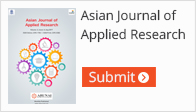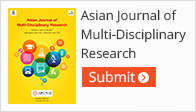Studies on Nanotitania and Betel Leaf Powder-based Water Treatment Collected from Tiruvannamalai District
T. Vijayalakshmi, G. Elango, S. Guhanathan| Journal Title | : | Asian Journal of Applied Research |
|---|---|---|
| DOI | : | DOI: http://dx.doi.org/10.20468/ajar.2019.1.01 |
| Page No | : | 01-09 |
| Volume | : | 5 |
| Issue | : | 1 |
| Month/Year | : | 3/2019 |
Keywords
Activated Betel leaf, Adsorption Isotherm, Nanotitania, Parameters, Photocatalytic reaction
Abstract
Several techniques have been practiced for the purification of wastewater, possibly utilization of nanomaterials found to be the recent trend. According to this trend, photocatalytic water treatment using nanotitania is a well-known advanced remedy for acute water scarcity problem. Semiconductor metal oxides such as ZnO, Fe2O3, and TiO2 having photocatalytic property were used. The use of nanotitania was implemented on water treatment, due to its chemical stability, larger surface area, and photocatalytic activity. In this study, nanotitania was synthesized by sol–gel method and its structure was characterized by X-ray diffractometer, transmission electron microscopy, and field emission scanning electron microscopy. Collected wastewater samples were treated with prepared nanotitania and its physicochemical parameters have been studied. Betel leaf was found to be more popularly known treatment for chronic cough and indigestion problem which is relatively natural and biosorbent. Its adsorption isotherm experimental parameters were investigated using methylene blue as adsorbate. Photocatalytic decolorization of methylene blue dye was studied with TiO2. Nanotitania was found to be eco-friendly, having more efficient, for the treatment of wastewater.


